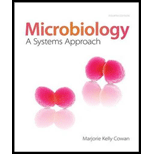
Microbiology: A Systems Approach
4th Edition
ISBN: 9780073402437
Author: Marjorie Kelly Cowan Professor
Publisher: McGraw-Hill Education
expand_more
expand_more
format_list_bulleted
Question
Chapter 12.3, Problem 8AYP
Summary Introduction
To distinguish:
Difference between broad-spectrum and narrow-spectrum antimicrobicidal, and also explain the significance of the distinction.
Concept introduction:
Drugs that are used to treat the microbial infections are commonly referred to as antimicrobial agents. Antimicrobials can be divided into two groups that are broad-spectrum and narrow-spectrum.
Expert Solution & Answer
Want to see the full answer?
Check out a sample textbook solution
Students have asked these similar questions
glg 112 mid unit assignment Identifying melting processes
Give only the mode of inheritance consistent with all three pedigrees and only two reasons that support this, nothing more, (it shouldn't take too long)
O
Chapter 12 Solutions
Microbiology: A Systems Approach
Ch. 12.1 - State the main goal of antimicrobial treatment.Ch. 12.1 - Identify sources of the most commonly used...Ch. 12.1 - Summarize two methods for testing antimicrobial...Ch. 12.1 - Prob. 4AYPCh. 12.2 - Prob. 5AYPCh. 12.2 - Describe the five major targets of antimicrobial...Ch. 12.2 - Identify which categories of drugs are most...Ch. 12.3 - Prob. 2CFCh. 12.3 - Prob. 8AYPCh. 12.3 - Trace the development of penicillin...
Ch. 12.3 - Prob. 10AYPCh. 12.3 - Prob. 11AYPCh. 12.3 - Prob. 12AYPCh. 12.3 - Prob. 13AYPCh. 12.3 - Identify the cellular target of quinolones, and...Ch. 12.3 - Prob. 15AYPCh. 12.3 - Prob. 16AYPCh. 12.3 - Prob. 17AYPCh. 12.3 - Prob. 18AYPCh. 12.3 - Describe two major modes of action of antiviral...Ch. 12.4 - Prob. 20AYPCh. 12.4 - Prob. 21AYPCh. 12.4 - Discuss at least three novel antimicrobial...Ch. 12.5 - Distinguish between drug toxicity and allergic...Ch. 12.5 - Prob. 24AYPCh. 12 - Prob. 1CFCh. 12 - Prob. 1MCQCh. 12 - Prob. 2MCQCh. 12 - Prob. 3MCQCh. 12 - Microbial resistance to drugs is acquired through...Ch. 12 - Prob. 5MCQCh. 12 - Prob. 6MCQCh. 12 - Prob. 7MCQCh. 12 - Which of the following modes of action would be...Ch. 12 - Prob. 9MCQCh. 12 - Prob. 10MCQCh. 12 - Prob. 11TFCh. 12 - Prob. 12TFCh. 12 - Biofilms are difficult to treat and do not always...Ch. 12 - Prob. 14TFCh. 12 - Prob. 15TFCh. 12 - Construct a paragraph describing the...Ch. 12 - Prob. 2CTQCh. 12 - Prob. 3CTQCh. 12 - Prob. 4CTQCh. 12 - Prob. 5CTQCh. 12 - Prob. 6CTQCh. 12 - Antibiotic-resistance genes, as well as other...Ch. 12 - Prob. 8CTQCh. 12 - Prob. 9CTQCh. 12 - Prob. 10CTQCh. 12 - Prob. 1CCCh. 12 - Prob. 2CCCh. 12 - Figure 12.5. Where could penicillinase affect each...Ch. 12 - From chapter 6, process figure 6.14a. Describe as...Ch. 12 - Prob. 1CM
Knowledge Booster
Learn more about
Need a deep-dive on the concept behind this application? Look no further. Learn more about this topic, biology and related others by exploring similar questions and additional content below.Similar questions
- Describe the principle of homeostasis.arrow_forwardExplain how the hormones of the glands listed below travel around the body to target organs and tissues : Pituitary gland Hypothalamus Thyroid Parathyroid Adrenal Pineal Pancreas(islets of langerhans) Gonads (testes and ovaries) Placentaarrow_forwardWhat are the functions of the hormones produced in the glands listed below: Pituitary gland Hypothalamus Thyroid Parathyroid Adrenal Pineal Pancreas(islets of langerhans) Gonads (testes and ovaries) Placentaarrow_forward
- Describe the hormones produced in the glands listed below: Pituitary gland Hypothalamus Thyroid Parathyroid Adrenal Pineal Pancreas(islets of langerhans) Gonads (testes and ovaries) Placentaarrow_forwardPlease help me calculate drug dosage from the following information: Patient weight: 35 pounds, so 15.9 kilograms (got this by dividing 35 pounds by 2.2 kilograms) Drug dose: 0.05mg/kg Drug concentration: 2mg/mLarrow_forwardA 25-year-old woman presents to the emergency department with a 2-day history of fever, chills, severe headache, and confusion. She recently returned from a trip to sub-Saharan Africa, where she did not take malaria prophylaxis. On examination, she is febrile (39.8°C/103.6°F) and hypotensive. Laboratory studies reveal hemoglobin of 8.0 g/dL, platelet count of 50,000/μL, and evidence of hemoglobinuria. A peripheral blood smear shows ring forms and banana-shaped gametocytes. Which of the following Plasmodium species is most likely responsible for her severe symptoms? A. Plasmodium vivax B. Plasmodium ovale C. Plasmodium malariae D. Plasmodium falciparumarrow_forward
- please fill in missing parts , thank youarrow_forwardplease draw in the answers, thank youarrow_forwarda. On this first grid, assume that the DNA and RNA templates are read left to right. DNA DNA mRNA codon tRNA anticodon polypeptide _strand strand C с A T G A U G C A TRP b. Now do this AGAIN assuming that the DNA and RNA templates are read right to left. DNA DNA strand strand C mRNA codon tRNA anticodon polypeptide 0 A T G A U G с A TRParrow_forward
arrow_back_ios
SEE MORE QUESTIONS
arrow_forward_ios
Recommended textbooks for you
- Essentials of Pharmacology for Health ProfessionsNursingISBN:9781305441620Author:WOODROWPublisher:Cengage
- Surgical Tech For Surgical Tech Pos CareHealth & NutritionISBN:9781337648868Author:AssociationPublisher:CengageBasic Clinical Lab Competencies for Respiratory C...NursingISBN:9781285244662Author:WhitePublisher:Cengage

Essentials of Pharmacology for Health Professions
Nursing
ISBN:9781305441620
Author:WOODROW
Publisher:Cengage




Surgical Tech For Surgical Tech Pos Care
Health & Nutrition
ISBN:9781337648868
Author:Association
Publisher:Cengage

Basic Clinical Lab Competencies for Respiratory C...
Nursing
ISBN:9781285244662
Author:White
Publisher:Cengage
USMLE-Rx Antimicrobial Therapy; Author: USMLE-Rx;https://www.youtube.com/watch?v=Pka1Ynlrqtw;License: Standard Youtube License